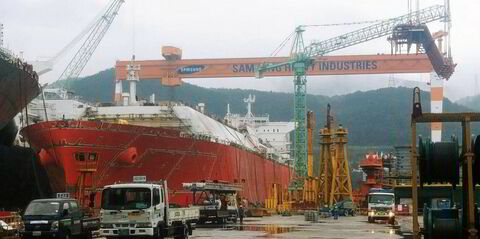John Fredriksen-backed Flex LNG has firmed up $315m of loans for its first three newbuildings in Korea.
The Oslo-listed company said an offer for a $315m term loan facility (TLF) has been received, secured by three of six newbuildings with delivery in the first half of 2018.
Six lenders are involved, with debt maturing over five years.
Two of the LNG carriers are coming from DSME and one from Samsung.
The facility does not contain a requirement that Flex obtains firm term employment for any of the LNGCs financed under it.
Financial covenants are not linked to earnings, but include balance sheet requirements that book equity exceeds 25% of total assets and that free cash is higher than $15m and 5% of net interest-bearing debt.
"The structure of the TLF allows for an opportunistic employment approach designed to maximize the company’s exposure to periods of strength in the LNGC rate environment," Flex said.
It can also seek to borrow more if it secures longer-term employment for a vessel financed under the facility.
CFO Oystein Kalleklev said: "The financing structure allows us to adjust the facility size depending on how we elect to employ our vessels and to substitute pledged vessels. This structure provides us significant balance sheet and operational flexibility as we grow our business."
Ships handed back
The company has been operating four chartered-in LNGCs to be able to establish a market presence and build an operational track record.
At the end of the third quarter, it redelivered two of these, the 159,924-cbm Energy Atlantic (built 2015) and 155,000-cbm Yenisei River (built 2013), while the remaining two had their deals extended by a further 180 days.
They will be handed back in the first quarter of 2018.
Flex said: "The company will continue to evaluate opportunities to charter in third party LNGCs to the extent that they will provide a positive contribution to the earnings position, although the company’s primary commercial focus is to secure attractive employment for its newbuildings."
It posted a net loss of $4.03m in the third quarter, compared to $0.53m a year ago.
Revenue was $9.8m, against zero in 2016, but vessel operating costs were $12.98m.
CEO Jonathan Cook said: "Over the past months, there has been upward pressure on charter rates as the LNG shipping market has tightened considerably, and we continue to see a trend towards a three-tier market with modern gas injection LNG carriers commanding a premium.
" As our fleet of state of the art newbuildings begins to deliver in the first quarter of 2018, we believe that a continued strengthening of structural fundamentals in the LNG sector will improve the rate environment further and provide us with various attractive employment options for our vessels."




